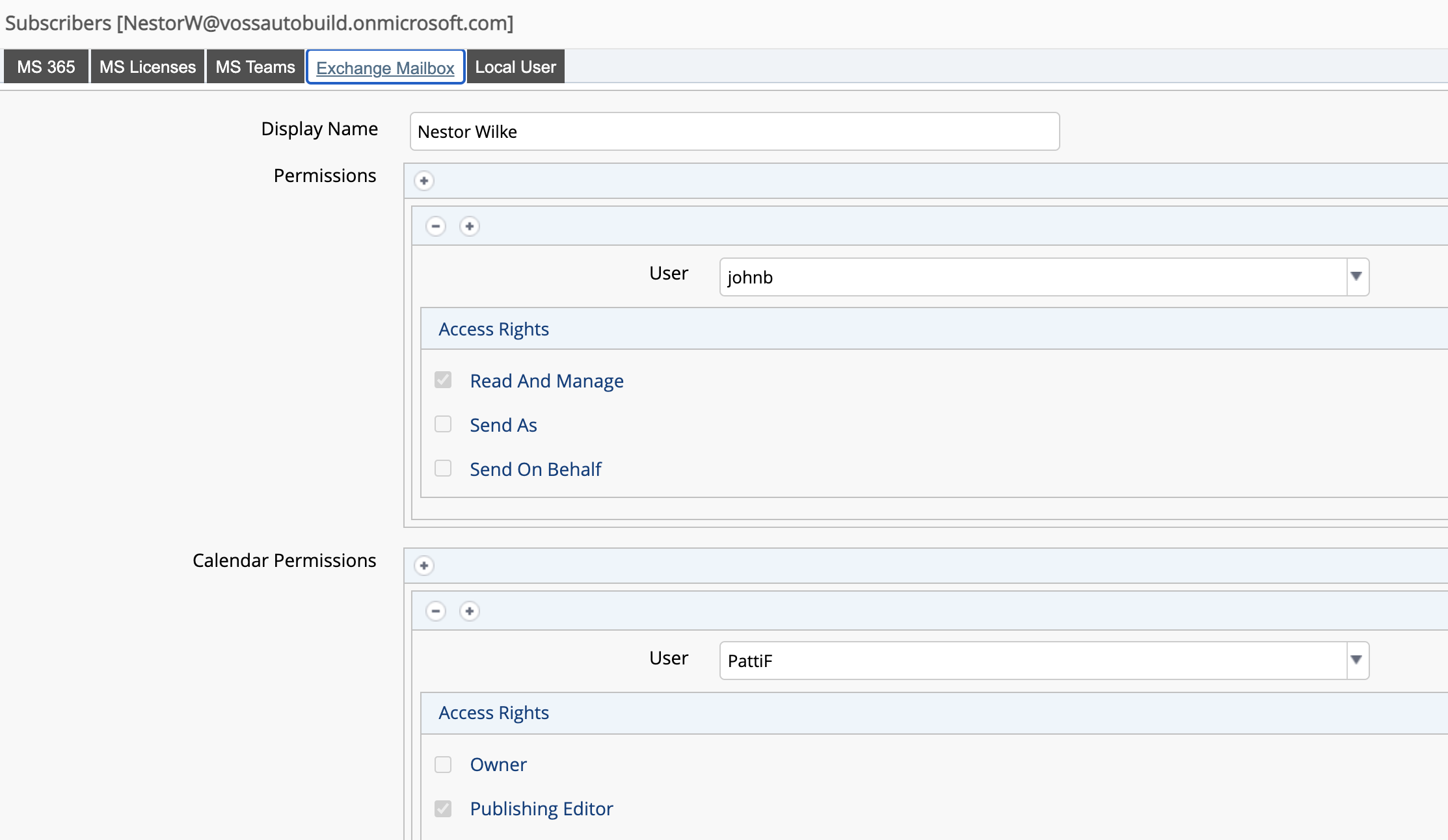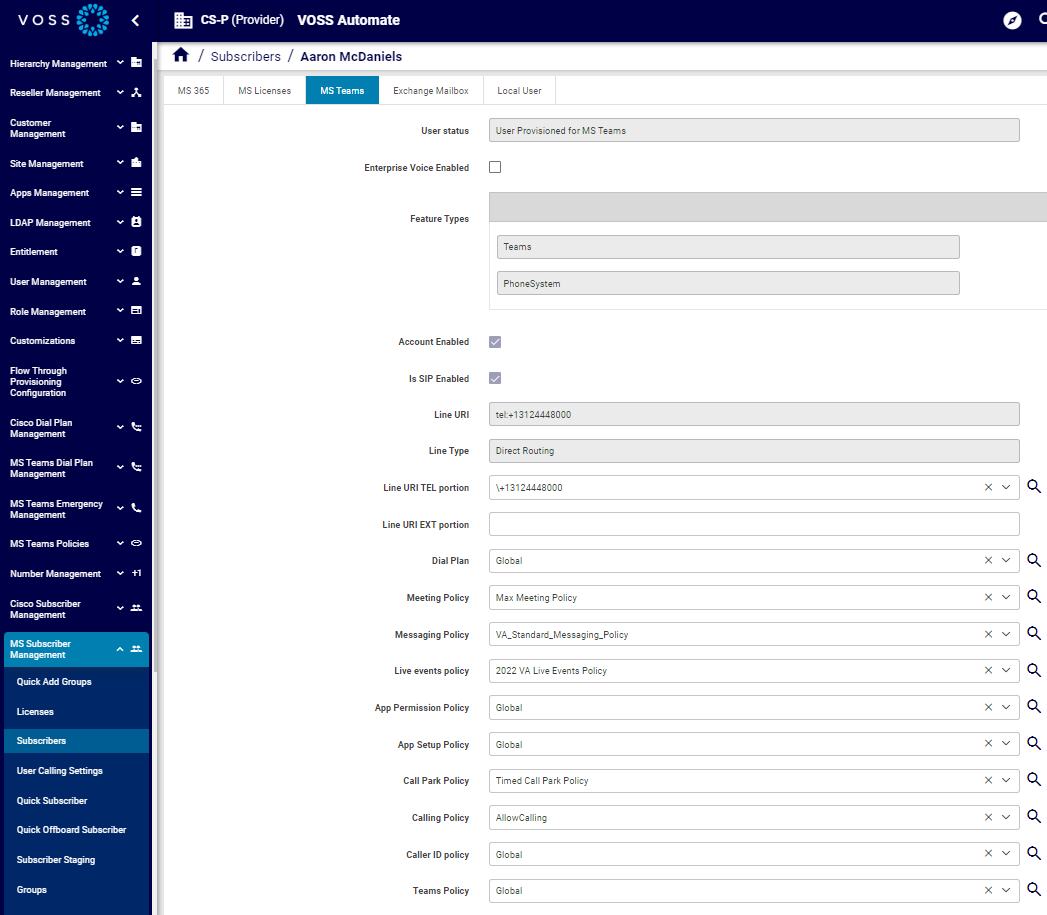Microsoft Subscribers#
Overview#
You will need to onboard Microsoft users to create Microsoft subscribers in VOSS Automate.
Onboarding a Microsoft user involves importing users and related data to the customer level from the Microsoft Cloud service, and then moving users to the correct sites as fully provisioned subscribers.
Automated workflows configure imported objects once changes are synced in, and apply the required configuration, policies, and licenses. This means administrators won’t need to continually monitor the sync, or to perform additional steps to complete the process.
Once synced in (at the customer or site level), administrators can manage Microsoft users and subscribers via a single interface and login, from within the VOSS Automate Admin Portal. To maintain data integrity, to manage licenses, and to automate number auditing for synced in users, regular, targeted backend syncs poll for changes made at the device model layer.
Related Topics
Onboarding Microsoft Users#
VOSS Automate provides two onboarding options for Microsoft users:
Sync users to customer level, and then to sites |
Configure VOSS Automate for Microsoft Services This option starts with an initial import of dial plans, policies, licenses, and Microsoft users, to the customer level (sync all to the tenant). Then you will need to set up the configuration and user move criteria before moving users to the sites (set up model filter criteria, site defaults, quick add groups, subscriber profiles, and number inventory). Finally, you have two options to move users to the sites as fully provisioned subscribers:
When moving users to site, the VOSS Automate automated workflow applies the required configuration, services, lines, policies, and licenses. |
Sync users directly to sites |
Sync with Flow Through for Microsoft In this option, you run the initial sync together with flow through provisioning. In this case, you start by setting up the configuration and user move criteria before running the initial sync. That is, to set up the model filter criteria, site defaults, quick add groups, and subscriber profiles. In addition, you will need to:
Once changes are synced in from the Microsoft Cloud, VOSS Automate automated workflows move the tenant dial plan, policies, and licenses to the customer level, and moves users directly to the appropriate sites as fully provisioned subscribers. |
Note
VOSS Automate v21.2 introduced sync with flow through provisioning for Microsoft users. In 21.3, this feature extends the functionality to users synced in from LDAP and CUCM (Call Manager).
Only Add is supported for syncs with flow through provisioning. Update and delete are not supported since the requirements may differ depending on the customer scenario.
For details on the generic flow through provisioning feature (which includes Microsoft, LDAP, or CUCM users), see Setting up Flow Through Provisioning
View and Edit Microsoft Subscribers#
This procedure displays and edits Microsoft subscribers.
View a summary list of all Microsoft subscribers
Log in to the VOSS Automate Admin Portal.
Choose the hierarchy.
Go to (default menus) Microsoft Subscriber Management > Subscribers.
On the Subscribers list, view a summary of Microsoft subscribers at the current hierarchy.
The Subscribers summary list view for Microsoft users provides details for the following, for each subscriber in the list:
User principal name, first name, and last name
Licenses
Department
City, country, phone number, location
Associated device
View and update a single Microsoft subscriber
Note
This workflow is intended for Microsoft-only users. When choosing a hybrid user with Cisco-Microsoft services, you’ll need to work with this user via the Hybrid multi vendor actions. The Hybrid Status Message field displays the user’s hybrid status. See Hybrid Cisco-Microsoft Management
Log in to the VOSS Automate Admin Portal.
Choose the hierarchy.
Go to (default menus) Microsoft Subscriber Management > Subscribers.
On the Subscribers list, view a summary of Microsoft subscribers at the current hierarchy.
Click on a subscriber in the list to open the Subscribers[subscriber name] page.
Select one of the tabs on the page to view or update settings:
Tab |
Description |
|---|---|
MS 365 |
Microsoft user. |
MS License |
View, add, or delete this subscriber’s Microsoft licenses. |
MS Teams |
The Microsoft subscriber’s MS Teams details. The fields below are read-only:
On this tab you can also enable or disable Enterprise Voice for this user.
|
Exchange Mailbox |
The subscriber’s user mailbox settings. You can update the mailbox display name, assign mailbox and calendar permissions to another user. See Microsoft Exchange in the Core Guide for details around managing other Microsoft Exchange mailbox types, such as shared or room mailboxes, or distribution groups. |
Local User |
The user corresponding with this subscriber. |
Save your changes.

Manage a Subscriber’s MS Teams Policies#
This procedure displays and updates the policies of individual subscribers via the Subscriber edit functionality:
Note
Some policies support full CRUD (create, update, delete) operations within VOSS Automate.
Note
This workflow is intended for Microsoft-only users. When choosing a hybrid user with Cisco-Microsoft services, you’ll need to work with this user via the Hybrid multi vendor actions. The Hybrid Status Message field displays the user’s hybrid status. See Hybrid Cisco-Microsoft Management
Go to (default menu) Subscriber Management > Subscribers.
Click on a subscriber to open the Subscribers [subscriber name] page.
Select the MS Teams tab.
View currently applied policies for the subscriber.
To choose different policies, click the down-arrow at the relevant policy, and select an alternative from the drop-down.
Save your changes. Policy changes are synced back to the Microsoft cloud when performing an overbuild or a sync.

